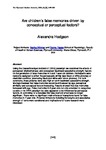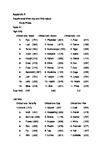Are children's false memories driven by conceptual or perceptual factors?
| dc.contributor.author | Hodgson, A. | |
| dc.date.accessioned | 2019-05-17T11:13:33Z | |
| dc.date.available | 2019-05-17T11:13:33Z | |
| dc.date.issued | 2015 | |
| dc.identifier.citation |
Evans, J. (2015) 'Are children's false memories driven by conceptual or perceptual factors?'. The Plymouth Student Scientist, 8(2), p. 149-163. | en_US |
| dc.identifier.issn | 1754-2383 | |
| dc.identifier.uri | http://hdl.handle.net/10026.1/14101 | |
| dc.description.abstract |
Using the Deese/Roediger-McDermott (DRM) paradigm we examined the effects of perceptual (distinctiveness) and conceptual (backward associative strength) factors on the generation of false memories in 5 and 7-year-old children. Participants were randomly assigned to either the perceptually similar (just black or white pictures) or dissimilar condition (alternating black and white with colour pictures). For both conditions, these pictures were also high or low in backward associative strength. We hypothesised that false memories would be influenced by age, perceptual similarity and conceptual factors interacting. Results showed that true memories increased with age. False memories in 5 year olds not only extended to categories outside of the DRM paradigm but also appeared to be influenced by perceptual factors. In controlling for a yes-bias this false memory effect was no longer significant. There were no significant main effects or interactions found for false memories in 7 year olds. Potential limitations including list lengths and associative strength of items were considered and implications for future research were discussed. | en_US |
| dc.language.iso | en | en_US |
| dc.publisher | University of Plymouth | |
| dc.rights | Attribution 3.0 United States | * |
| dc.rights.uri | http://creativecommons.org/licenses/by/3.0/us/ | * |
| dc.subject | Deese/Roediger-McDermott (DRM) paradigm | en_US |
| dc.subject | effects of perceptual (distinctiveness) | en_US |
| dc.subject | conceptual (backward associative strength) factors | en_US |
| dc.subject | false memories | en_US |
| dc.title | Are children's false memories driven by conceptual or perceptual factors? | en_US |
| dc.type | Article | |
| plymouth.issue | 2 | |
| plymouth.volume | 8 | |
| plymouth.journal | The Plymouth Student Scientist |




